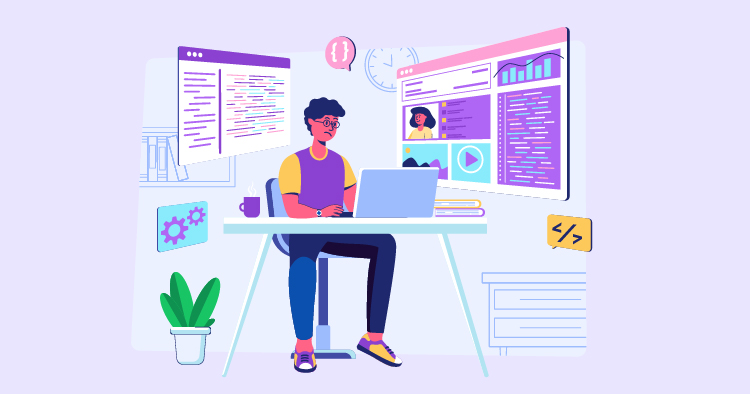Web development and design are like two sides of the same coin, both critical in crafting an engaging online space. Web development is all about the nuts and bolts of a website, making sure everything works under the hood. On the other hand, design is about making a website a joy to look at and interact with. When these two come together, they create a solid foundation for a digital platform that draws the eye and works like a charm. This partnership is more than just about beauty; it’s about creating a smooth, intuitive experience for everyone who visits the site. Let’s dive into how web development and design work hand in hand to make websites that are good to look at and function excellently.
Understanding Web Development
Web development makes a website work. It involves putting together the website’s core and ensuring everything runs smoothly. Developers work on the behind-the-scenes parts, like creating complex features, organizing data, and making sure the site can handle more visitors as the business grows.
Coding is the foundation of web development. Languages like HTML, CSS, and JavaScript shape the website. Frameworks help developers use these languages more effectively, making it easier to build complex sites. Responsive design is a must because so many people use their phones to go online. It means the website changes to fit different screens, which is important for keeping users happy and ranking well in search engine results, since search engines prefer sites that work well on mobile.
The Art of Web Design
Web design is about making the site look good and easy to use. It’s not just about colors and pictures; it’s about intuitively guiding users through the site. Good web design uses visuals to draw attention to important parts of the site and make it user-friendly.
User Experience (UX) and User Interface (UI) are crucial in web design. UX concerns the overall feel of the site, and UI concerns how the site’s buttons and menus work. They both ensure the site is not just lovely to look at but also easy and enjoyable.
A great-looking website can make a business stand out. It creatively uses images, graphics, and design elements to grab attention and express the business’s message. A beautiful website is critical to making a powerful impression online.
The Synergy Between Web Development and Design
When web development and design work together, the result is a website that stands out. It’s all about developers and designers joining forces to ensure the site is easy to use and beautiful. They aim to create a smooth ride for users from the moment they arrive to when they leave, with no bumps.
Web developers and designers can’t overstate the importance of teamwork. It’s like the gears in a well-oiled machine—each part needs to work with the other to function correctly. They have to talk regularly, work as a unit to tackle problems, and devise creative ways to make a site that’s both nice to look at and works like a dream.
Select one of over 500 designs and establish your online presence.
- Free Web Hosting
- Fully Managed Solutions
- Scalable Websites
- No Hidden Cost
Starting with design in mind when building a website can lead to some pretty excellent and user-friendly results. This way, design and function go hand in hand, ensuring every part of the site is made with the user’s experience in mind.
Optimizing Websites for Search Engines
Getting your website to appear in search engine results is a big deal, and that’s where SEO comes in. It’s about making tweaks to your site, like improving the content, organizing it better, and ensuring the behind-the-scenes details (like metadata) are on point. Doing SEO well means more people might come across your site when they’re searching for something you offer.
Finding and using the right keywords is a big part of SEO. Businesses need to determine what words people use to search for what they offer. Then, they can sprinkle these words throughout their site—in the titles, headings, and content—to make it more likely that their site will pop up in search results.
There are a bunch of ways to make your website more noticeable. Keeping your content fresh and top-notch is one way. If you’re a small business, ensuring people in your area can find you online is super important. Plus, having a site that works well on phones and loads quickly makes for happier visitors, which search engines love. Customer reviews can help make the site more trustworthy and inviting, increasing sales and customer loyalty.
Enhancing User Engagement
Your website must be beautiful and functional to grab and keep users’ attention. With so many online options, a site must shine to draw people in. This means not just having a good-looking interface but also one that invites interaction and participation.
Adding interactive features like animations, hover effects, videos, and infographics can make a website lively and fun. These features can lead to a more engaging and memorable experience, making visitors stay longer and dig deeper into what you offer.
Keeping visitors engaged means offering them content that’s both useful and interesting. This includes well-written text, high-quality visuals, and straightforward navigation. When users find it easy to get around your site and access the information they need, they’re expected to have a better overall experience.
The Impact of Web Development and Design on Branding
A robust website acts as a digital face for your brand. It shows off what your brand stands for, its personality, and its level of professionalism. An excellent website can help build trust and credibility with visitors, which is critical to growing your brand and getting recognized.
For a brand to stick in people’s minds, it’s important to keep branding elements like logos, colors, fonts, and images consistent across your website. This helps ensure visitors have a smooth and memorable experience, which can make your brand more recognizable.
Select one of over 500 designs and establish your online presence.
- Free Web Hosting
- Fully Managed Solutions
- Scalable Websites
- No Hidden Cost
Many companies have used web development and design to boost their branding. They know that a well-designed website can be a powerful marketing tool that effectively shares their brand’s story and connects with the right people. These success stories can show other businesses how much a great website can do for their brand.
E-commerce and Web Development
For e-commerce, web development is critical to creating a site that works well and is secure. This includes setting up shopping carts, product catalogs, and systems for managing user accounts. A well-built e-commerce site should make shopping easy and encourage customers to buy and keep returning.
For e-commerce, it’s critical to handle payments safely and reliably. Using well-known payment gateways and security certificates helps protect customer information and builds trust. A smooth checkout process with simple instructions and various payment methods can also improve the shopping experience, leading to fewer abandoned carts and more sales.
The design of an e-commerce site is just as crucial as its technical build. A good-looking and user-friendly design can influence customers’ opinions and willingness to buy. This includes creating attractive product displays, easy navigation, and a layout that guides shoppers through purchasing. Product pages with detailed descriptions, quality photos, and customer reviews add to the site’s credibility and appeal, boosting sales and customer satisfaction.
The Future of Web Development and Design
Web development and design are fields that never stand still as new technologies and approaches emerge. Artificial Intelligence (AI) and machine learning lead the charge, offering fresh ways to make websites more engaging. With augmented reality (AR) and virtual reality (VR), how we interact with websites is on the brink of transformation. For developers and designers, keeping up with these trends is vital to staying ahead in the game.
AI and machine learning aren’t just buzzwords; they’re changing the game in web development and design. These technologies make it possible to tailor user experiences by understanding user data and habits, leading to more brilliant websites that know what users want. They also make web development more efficient by taking over repetitive tasks and providing deeper insights into user behavior. This move towards integrating new tech means websites are becoming more responsive and focused on the user’s needs.
Staying adaptable and innovative is essential to thrive in the fast-paced world of web development. Businesses and web professionals should continually explore new technologies and approaches. Investing in education, trying out new tools, and being ready to shift perspectives are all part of this process. Innovation is not just about keeping up; it’s about pushing boundaries and discovering new ways to solve problems and express creativity.
Web Development and Design for Mobile Apps
Mobile apps are now a crucial element of any business’s online presence. As smartphone use grows, mobile apps must be as compelling and user-friendly as desktop websites. They offer a unique way to connect with customers and can deliver a more tailored experience.
Developing for mobile is a different ballgame than for the web. It demands understanding mobile-specific features and constraints, such as touch interfaces and smaller displays. Mobile apps often need to function without an internet connection and require a different approach to layout and navigation. Grasping these distinctions is crucial for crafting practical mobile applications.
Creating a standout mobile app involves several important factors. It should be quick and responsive, with an easy-to-navigate user interface. The design should focus on simplicity and accessibility, ensuring essential features are easy to find and use. Push notifications can keep users engaged, and updating the app regularly helps it stay valuable and relevant.
The Role of Programming in Web Design
Programming is becoming increasingly central to web design. Knowing languages like JavaScript, Python, or PHP allows designers to bring more life and interactivity to websites. By incorporating coding into the design process, designers can customize websites in new ways and enhance their functionality.
For designers, learning to code can be a game-changer. It lets them create more complex and engaging designs, helping websites to stand out. These skills also improve developer teamwork, making projects go smoother and results more cohesive. Designers looking to get into programming have lots of learning options. Online platforms such as Codecademy, Udemy, and Coursera offer a range of programming courses for different levels. Local workshops, webinars, and coding boot camps are also great for hands-on experience. Staying on top of learning is vital in web design, where things constantly change.
The Importance of Speed and Performance
The speed at which a website loads is crucial for keeping visitors happy and engaged. When a site responds quickly, users are likelier to stay, browse, and interact with the content. Slow websites can frustrate visitors, leading them to leave—or “bounce”—which is not suitable for business. Search engines like Google also pay attention to site speed, so a faster website can help you appear higher in search results, making it easier for people to find you.
Improving a website’s speed involves a few key actions. You can start by making your images and media files as small as possible without losing quality. This reduces the amount of data that needs to be loaded. Using browser caching lets visitors store parts of your site on their device so it loads faster the next time they visit. Also, you can speed things up by reducing the time your webpage needs to ask for information from the server (HTTP requests). Clever coding with CSS and JavaScript can make a big difference, too.
To get your website moving, designers and developers need to work together. They need to pick the best hosting service, ensure content and images are optimized for quick loading, and use coding practices that don’t slow things down. It’s also a good idea to check how fast your website is running regularly and fix any speed bumps as they occur.
Security in Web Development and Design
For small businesses, keeping a website secure is non-negotiable. It’s about more than just protecting your data; it’s about safeguarding your customers’ personal information. A compromised website can lead to severe problems such as stolen data, legal headaches, and a loss of customer trust. This can hurt your business’s reputation and bottom line.
Developers and designers are on the front lines of making websites secure. They need to use best practices in coding, keep all software up to date, and use tools and plugins that help protect against hackers. Ensure your website has an SSL certificate, which encrypts data, and use secure methods for processing payments, which are also crucial steps. Regularly checking your site for vulnerabilities can keep it safe from attacks.
To avoid cyber threats, it’s essential to be aware of the latest security measures. Strong passwords, two-factor authentication, and frequent backups can significantly improve your website’s security. Also, teaching your team and users about safe online practices can be a powerful way to prevent security issues. Keeping everyone informed and vigilant is a smart way to defend against cyber risks.
The Cost of Web Development and Design
Creating a website can have a price tag that varies as much as the websites themselves. Several elements play a role in determining the ultimate cost. The price will likely increase if your project is complex or requires unique, tailor-made features. The expertise of the people building your website also matters; seasoned professionals might charge more for their services. If you opt for high-end tools or software, this will reflect in the overall cost. It’s not just about the setup; think about the future. You’ll need to budget for the website’s care, which includes regular updates and technical support.
When you’re running a small business, every penny counts. That’s why it’s crucial to plan your website expenses carefully. Starting costs are just the beginning. You’ll also have to consider the recurring costs of keeping your website online and in good shape, such as hosting fees and updates. To keep your spending in check, focus on what’s necessary for your website at the start. This way, you can have a professional-looking online space without breaking the bank.
Spending money on a professionally made website is an investment that pays off. A well-crafted site can attract and keep customers around, leading to more sales. It also helps create a good impression of your brand. An excellent website can also grow with your business, adapting to new trends and customer needs. This flexibility ensures that your online presence remains vital and relevant.
Final Thoughts
They are grasping how web development and design work together, which is critical for anyone who wants to build a website that makes an impact. It’s not just about a website that works flawlessly or one that’s a visual treat; it’s about striking a harmony where every part complements the other. As the digital world keeps changing and users expect more, the teamwork between developers and designers is more vital than ever. When these professionals combine their expertise, they can create digital experiences that are eye-catching, smooth to use, and effective.



